Why We Use Fruiting Bodies in Our Mushroom Products (and why that matters… a lot!)
People often ask us at West Wolf Medicinals why we use only the fruiting bodies of mushrooms in our products.
It's not something most people know is important unless maybe they are mycologists. This topic matters so much to us, as our business is anchored in the medicinal powers of fruiting bodies, that we decided to devote more details to it. Please read on and shop our medicinal mushrooms today!
A good place to start is why we are guided by our vision:
“Ancient Medicine Backed by Modern Science.”
Functional mushrooms have been used by humans for over 5,000 years in cultures across the world, from Europe to China, and recently dried medicinal mushrooms have been found on ancient humans over 50,000 years old.
Today, the mushroom supplement marketplace is dominated by products that don’t actually contain any mushrooms (more officially known as the “fruiting body”). Instead, these products are made of mycelium, the roots of the mushroom, and contain no mushrooms at all. Yet in all the thousands of years humans have used mushrooms, every single culture has always and only used the fruiting body exclusively — not the mycelium. They did not dig up the roots and consume it with the dirt (substrate).
This means that the vast majority of scientific studies and trials, all cultures with traditional herbal medicine, all fungi folklore, and ancient lineages have used the fruiting bodies of mushrooms.
While fruiting body research has thousands of years to back it, mycelium is a brand new emerging field with only a couple of decades of research. Existing research shows that fruiting bodies may have at least 15 times more active compounds than mycelium. By active ingredients, we’re talking about beta-glucans, triterpenes, and ergosterol — the compounds that actually give your body benefits (like focus, energy, immune and stress support, etc.).
Mycelium proponents may argue that although there are fewer active compounds in the mycelium, in nature, it has more exposure to "intruders" and therefore has built more immune factors — that you can’t quantify! Even if this was true, it is impossible to harvest mycelium from nature. They are grown in a sterile laboratory, so all mycelium products on the market are not exposed to any environmental factors. They also contain mostly the substance (grain/starch) they are grown on.
Additionally, if these sterile blocks are exposed to any “intruders,” the entire batch would be labeled contaminated, and the mycelium would be tossed away.
“Mushrooms” labeled “US Grown” are almost always mycelium-based. But there’s more — they are not pure mycelium. You can not separate the mycelium from what it grows on. Mycelium grown in a lab is often grown on a grain substrate, and the grain ends up being a significant portion of the final product. So many so-called mushroom products are up to 90% grain (rice or oats) with 10% mycelium.
This means that basically, you are paying for high starch grain — ground-up grain with mycelium — and being tricked into thinking you are getting a functional medicinal mushroom that will have health benefits!
If a product uses mycelium, they can’t even call it a “mushroom,” according to the Food and Drug Administration.
There are real reasons why so many companies are crowding the mushroom market with mycelium-based products. And you can probably guess some of the reasons why.
It’s cheaper: Mycelium on grains costs about 10x less than organic fruiting body extracts. So if mycelium worked, then we would definitely want to use that in our products! We would make much more money on every order. There's literally no financial incentive for us to use fruiting body extracts over mycelium, especially since we can only charge what the market will bear. On the shelves, you will see very little difference in price between a mycelium-based product and ours. It’s no wonder these companies — and their products — are blowing up!
It tastes sweeter: Fruiting body extracts can taste umami and bitter, while the mycelium grown on grain tastes faintly sweet. Mycelium is significantly easier to formulate with. Though it would be much easier for us to make delicious blends with starchy mycelium, we work hard to blend fruiting bodies with other good-for-you ingredients like ginger and cinnamon to overcome the bitter taste.
At West Wolf Medicinals, we built our company to be best-in-class in the mushroom supplement world. We use only organic, fruiting bodies, extracted to our high potency, in all our products — just as they’ve been used for thousands of years in a way that helps everyone to meet the demands of our world.
Using the fruiting body is incredibly challenging. It is much more expensive, time-consuming, and difficult to make tasty (a potent mushroom extract tastes bitter), but we want to offer you real mushrooms — extracted fruiting bodies — that have the research and tradition standing behind them to help you on your health journey.
We hope this helps make a confusing subject easier to understand. If you have any questions about our medicinal mushrooms or mycelium-based products, don’t hesitate to reach out to us at West Wolf Medicinals — you can reach us at nicole@westwolfmedicinals.com.
